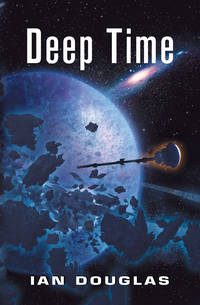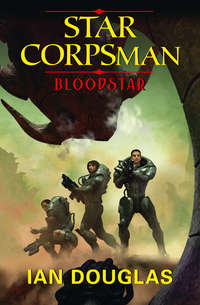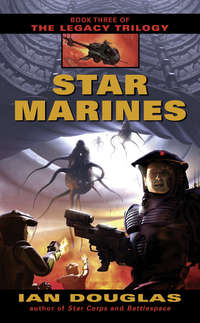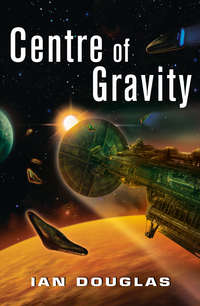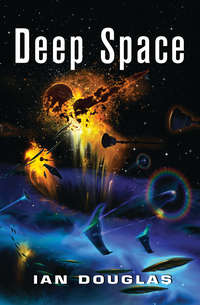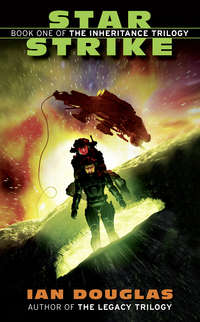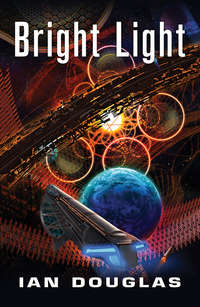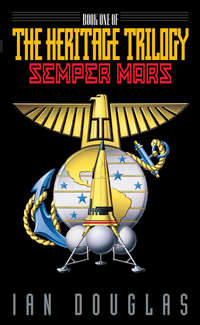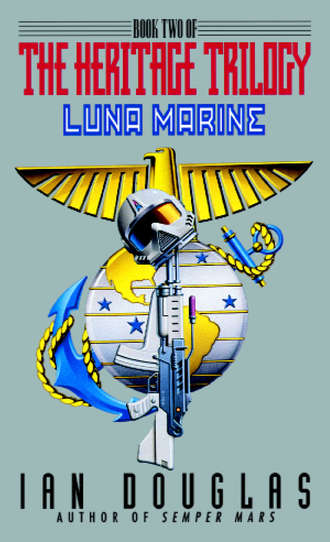
Полная версия
Luna Marine
The threat warning LED lit up in a flashing constellation of red.
“We’re being painted,” she said. The words were calm, unemotional, but suddenly her heart was pounding inside her chest. “Looks like traffic-control radar.”
“I see it. Maybe they’ll lose us against the mountains.”
The bug was dropping again, falling abruptly into shadow as it descended the inner face of the Crisium Ringwall. Ahead, the Mare Crisium stretched away clear to the black shadow of the terminator, flat and nearly featureless, the surface far darker than the sun-dazzled highlands had been. A large crater, flattened into a deeply shadowed oval by perspective, lay almost directly ahead.
“Picard,” Dow said, checking his displays. “Bang on target.”
The warning LEDs continued to show a strong radar signal coming from the crater ahead, though the mountains behind them might well be masking them from detection. Dow gentled the controls, smoothing and slowing the bug’s descent with several rapid-fire bursts from the attitude-control thrusters.
“Better let your Marines know we’re almost there,” he said. The oval of Picard was growing larger second by second, and also flatter, until all that was visible was a sunlit smear of smooth-shaped mountains, the crater’s ringwall extending above the surface of the darker basaltic sea. The LSCP had descended to within two hundred meters of the mare’s surface, below the top of the crater rim. Kaitlin approved. If the radar was coming from a grounded ship or lobber inside the crater basin, they should have just dropped below its horizon.
The threat indicator stayed on, however. That suggested that someone was watching them from the crater rim. It also suggested that that someone was waiting for them, waiting and ready for their arrival.
“Heads up, Marines,” she called over the platoon channel. “Target in sight. It looks like they see us coming, so be ready to unstrap and bounce as soon as I give the word.”
Dow hit the main thrusters again, dropping the craft’s nose to accelerate toward the target. Kaitlin found herself twisting her body so that she could peer up through her helmet visor at the rimwall mountains as they filled the cockpit’s forward window. She knew she ought to be watching the graphic displays instead—those carried more information than the naked-eye view out the bow of the LSCP—but she found herself wrestling with the terribly human urge to see the threat directly, instead of as it was implied by the craft’s electronics. Additional red LED readouts were winking on now, indicating other radar transmitters joining the first.
“I think—” she said, then stopped. A dazzling star appeared on the mountaintop, winking on, then off with the suddenness of a camera’s strobe.
“Did you see that?” Dow asked. Apparently, he preferred looking with his eyes instead of electronics as well.
“Sure did. There…to the right a bit.”
“Your call. Pass it by, or have a look?”
“We look,” she decided. “Definitely. We’re supposed to land up there to cover First Platoon. I think we’d better check that flash out.”
“Roger that.” The bug banked right and Dow cut in the main thrusters, clawing for altitude. Kaitlin watched for a second flash, but saw nothing. It had been about there…between those two rounded peaks at the crest of the crater rim. It might have been sun reflecting from a cast-off bit of space junk from the UN arky team at the crater, but she was betting that a flash that bright had come from something pretty large—as large, say, as the cockpit windows of a Lunar hopper or a ground crawler.
“Gimme a channel to 30.”
He keyed in some numbers on the commo console. “Plug in there.”
Kaitlin pulled a commo jack from the connector box on her suit’s belt, plugging it into the console receptacle. “Eagle,” she called. “Eagle, this is Raven.”
“Raven, Eagle,” Carmen Fuentes’s voice came back almost at once. “Go.”
Kaitlin checked the time readout inside her helmet. If LSCP-30 was on its mission profile, it would still be over the Mare Tranquillitatus, shielded from UN radar by the Crisium Ringwall. A military communications satellite at L-2 allowed the two bugs to stay in tight-beamed, scrambled contact despite the mountains between them. “We’ve got a possible hostile OP on the Picard Crater rim,” she said. “TC radar and transient visual. We’ll try to take it down before you clear the Crisium wall and get painted.”
“Copy that, Raven. We’ll relay to Falcon. If you run into trouble, give him a yell.” Falcon was the call sign for LSCP-38, bringing up the rear with Captain Lee and Alfa Company’s Second Platoon. Good luck!”
“Thank you, Eagle. Luck to you. Raven out.”
In another moment, LSCP-44 crested the Picard Crater rim, angling between the two peaks Kaitlin had identified seconds before. The crater was a vast bowl stretching clear to the horizon and beyond; she couldn’t even see the far crater wall. The bowl’s floor, five kilometers below the rim, was shrouded in impenetrable black shadow, but a cluster of lights in the near distance marked the UN’s Picard Base.
And then, on the sunlit crest ahead, she saw it, an enclosed Lunar hopper with pale blue UN markings, just rising above a swirling cloud of gray dust. Sunlight flashed again from the facets of its greenhouse windows. The spindly-legged craft was quite similar to the LSCP, though designed around a square base, instead of a rectangular one. It looked a lot like a larger version of the old LEMs, the Lunar Excursion Modules that NASA had used for the first landings over seventy years before, but the resemblance was one of design specifications rather than descent. Spacecraft didn’t need streamlining on the Moon, so efficiency and low mass were the key words. Hoppers, like the LSCPs, flew on fission-fired plasma thrusters; they weren’t rated for flights between the Moon and LEO, but they could reach Lunar orbit, easily enough, and could use short bursts to hop on suborbital vectors to any spot on the Moon.
“He’s making for the base,” Kaitlin said. “He’s probably already warned them.”
“I’m more worried about him getting above us,” Dow replied. The UN hopper slewed left, rotating, slowing sharply as it hovered on its invisible jet of hot plasma and rising toward the LSCP’s height.
“Why?” Kaitlin asked. Then the answer hit her. “Oh…”
Neither hopper nor LSCP carried anything like armor. The hopper’s aluminum hull was so thin in places that a clumsily dropped tool could puncture it…and the more massively constructed LSCP wasn’t that much better. If one of the two craft could maneuver above the other, the jet of hot, charged particles from its ventral thrusters would become a formidable short-range weapon.
The UN hopper was climbing fast now, rising above the bug as the bug descended. As the range closed to within thirty meters, Kaitlin could see the airlock door on the hopper just beneath its cockpit windows; the door was open and a space-suited figure was leaning out, a figure wearing a bright blue UN helmet and aiming a rifle. She didn’t see a muzzle flash, but she thought she felt a vibration, a dull thud from somewhere beneath her feet.
“We’re under fire,” she warned.
“I see him.” Dow hit the main ventral thruster for a two-second burst, and Kaitlin felt her knees sag with the acceleration. The bug gained the altitude advantage on the hopper. A moment later, Dow angled the LSCP over, nose down, and fired again, banking slightly with the port thrusters to send the ungainly bug drifting across and above the UN hopper’s flight path.
There was no time for calculations or pulling up numbers or scenarios on the computer. The entire maneuver was strictly seat-of-the-pants, executed within the space of five seconds. As the bug passed ten meters above the hopper, Dow brought the ungainly craft’s nose up and fired the main thrusters again.
They couldn’t see whether the invisible burst of hot plasma was on target or not, but as the bug rotated slowly at Dow’s practiced touch, the other vehicle came into view a second later. Together, wordlessly, they watched as the hopper continued drifting down toward the surface, rushing to meet its own shadow…and then the two merged in a sudden, silent burst of Lunar dust. The hopper crumpled and rolled, cartwheeling in slow-motion bounds low across the surface, hurling up great, arcing jets of dust with each impact. As it came to rest, a blurring cloud of dust enveloped the wreckage, settling with agonizing slowness.
Kaitlin dropped a gloved hand on Lieutenant Dow’s shoulder. “Congratulations, Lieutenant. I think you just scored the first shoot-down of an enemy craft on the Moon.”
“Four more and I’m an ace,” Dow replied. He shook his head. “Don’t think I’d care to try that again, though.” Holding the stick in his left hand, he punched in a series of commands with his right, firing port and starboard attitude jets that thumped and bumped through the hull and against Kaitlin’s boots. The bug descended swiftly, narrowly missing a tumble of huge, gray boulders before the view was obscured by a cloud of rising dust, and the landing pads settled with a bump and a jar into the hard-packed regolith.
“Contact light!” Dow called, reaching out to flip down a row of switches. “Thrusters off and safed. Reactor to standby. You’re clear to debark.”
“Right.” She keyed the platoon channel. “Gunny Yates? We’re down. Move ’em out!”
“Copy that, Lieutenant. All right, Marines, you heard the lieutenant! We’re moving!”
LSCP-44, Call sign Raven
Picard Ringwall, The Moon
0914 hours GMT
Frank Kaminski brought his ATAR to his chest, waiting in the dark and close-packed confines of the airlock as the chamber’s atmosphere bled away. A winking red light flicked green, then the outer door swung slowly open, flooding the airlock with silvery light.
“Hit the beach, Marines!” Yates shouted over the platoon channel. “Go! Go! Go!”
He crowded ahead close behind Lance Corporal Nardelli, feeling the vibrations through his boots as the file pounded down the metal grating that served as a debarkation ramp. The regolith gave beneath his feet with a crunch felt rather than heard, like thin, crusty snow; directly ahead, the sun blazed above the shadowed western cliffs of Crisium, beneath the slender, just-visible blue-and-silver bow of a crescent Earth.
As at Fra Mauro, he felt again the mingled feelings of awe and desolation. There were no stars visible in the side of the sky near the sun, but if he turned away and looked up, an icy scattering of stars was just visible above the eastern horizon. The crater rim stretched away to either side, to north and south; with nothing but black sky and red-gray hills as smooth as earthly sand dunes as measures of scale, he felt bug-small, tiny and exposed, as he followed the other Marines across the surface.
“Jeez, what happened there?” someone called. “Got a crashed bug, here. South, fifty meters.”
“That’s a UN hopper, and we just shot it down,” the lieutenant’s voice replied. “Watch it. They may have left troops on the ground.”
“We’ll check it, Lieutenant,” Yates replied. “Okay! First Squad, check the hopper. Second Squad, deploy in defense perimeter. Let’s move it, Marines!”
Trotting easily in long, bounding strides that quickly slid into a kind of kangaroo hop-and-skip, Kaminski and the others in his squad scuffed and bounced their way up a shallow slope to the spot where the UN hopper, its thin hull crumpled and torn, lay upside down. A space-suited body, a man in a blue UN helmet, lay sprawled in his back nearby. His face, just visible through a blackened, chipped visor, was horribly blistered, as though his skin had been hit by a blowtorch. The name stenciled on a strip of cloth attached to his suit read LECLERC. Kaminski wondered who the man was…and if he had a family waiting for him back on Earth.
“What happened to him?” Ahearn asked.
“Didn’t you feel us bouncing around before we landed?” Kaminski replied. “I think the lieutenant fried ’em by hitting ’em with the bug’s main jets.”
“Yeah? Man, that’s doin’ it the hard way!”
He didn’t answer. He was thinking about something he’d read once, as a kid, about how air-to-air combat had begun when pilots on both sides, flying cloth-and-wood-frame biplanes over France in the First World War, had begun carrying pistols with them on reconnaissance flights and exchanging shots with enemy fliers. Pistols had led to machine guns…and ultimately radar-homing missiles and airborne lasers. He wondered if they were witness to a dawn of a new and similar type of warfare.
There wasn’t time to think much about history, though. A squad sweep through the area turned up bits of scrap and wreckage knocked from the UN hopper, and a portable radar unit mounted on a tripod at the top of a low hill. The footprints scuffed and stamped into the dust showed where UN troops had set the radar up only moments earlier. After a careful check for booby traps, two of the Marines began dismantling the unit; Kaminski took the moment’s respite to turn his back on Earth and the sun and stare down into the crater bowl below them.
The bottom of the crater was night black, but enough light was scattering off the crater rim to provide a little illumination. In fact, though, the lights of the UN base shone like a tightly packed constellation of brilliant stars on the crater’s floor, only a few kilometers away. Yates was standing on the hill crest a few meters away, pressing the rubber-ringed facepiece of a photomultiplier magnifier to his visor. He was studying the layout of the UN base, the bulky length of his Wyvern resting in the dust by his feet.
Kaminski dropped the reload case he was humping in the dust nearby. “Hey, Gunny. Can I have a look?”
Yates handed him the electronic imager. Kaminski raised the facepiece, positioning the small, rectangular screen against his visor. A tiny IR laser built into the optics gave the range to target as 8.34 kilometers; in the pale green glow of the photomultiplier optics, he could penetrate the night shadows easily.
The Picard base consisted of several squat, upright, cylindrical habs and not much more besides the worklights and a scattering of vacuum-rigged bulldozers and trench-diggers. Not far away were several more lobbers, plus a larger, sleeker shape, an arrowhead of stealth-jet black, sitting erect on quad-frame landing jacks.
Closer, between the habs and the crater’s western slope, the ground had been carved and plowed in a rectilinear patchwork of trenches connecting several deep, square-sided pits. It was, Kaminski thought, obviously an archeological dig of some kind. The arky teams on Mars had used similar techniques to carve trenches into the Martian regolith, sampling the layers they cut through for artifacts and cast-off bits of debris.
All the scene below was missing was people. Funny. The UN personnel obviously had had plenty of warning that the Marines were on their way. They’d had time to dispatch the lobber and set up a portable radar unit. They’d probably been warned by the garrison at Fra Mauro the moment the Marines had first appeared
Were they all inside, huddled up in their suits, waiting to see if the Marines would come in with can openers at the ready?
“Seems a bit too quiet, Gunny,” he said to Yates. “Don’t see a damned thing moving down there. Ah! Wait a sec!”
“Whatcha got?”
“That black ship grounded down there. It’s lifting!” There was no flame, but the arrowhead shape was silently rising now above a swirl of lunar dust.
“Gimme the imager.”
Kaminsky surrendered the device. Without it, he could just see the UN ship vanishing into the night beyond the base.
“Shit,” Yates said. “They’re bugging out. Wonder if they’re evacuating the place? Or…”
“Or what, Gunny?”
“Or if they just stopped long enough to haul in some reinforcements. I don’t like the looks of this.” He lowered the imager again and handed it to Kaminsky. “They gotta know we’re here, all right. But…uh-oh. Here comes Eagle.”
Kaminski turned, following Yates’s pointing arm. Another bug was coming in out of the sun, floating high, passing above Picard’s rim by at least two hundred meters. Silently, it drifted overhead and a bit to the north, descending rapidly as it cleared the rim, floating on unseen jets of plasma toward the brilliantly lit base below. Halfway down, the ungainly looking craft switched on its landing lights, casting bright circles of illumination across the habs and trenches.
Kaminski watched a moment…then lifted the magnifier to his visor again, staring down into the base. There was something…
He saw movement…a trio of blue helmets raised above the rim of one of the trenches…and the stubby, metallic cylinder of a shoulder-launched missile. “Missile on the ground!” he shouted. “This is Kaminski, I have a slam, in the trenches fifty meters from the base habs!”
Yates jerked the imager from Kaminski’s glove, lifting it one-handed to his own visor. “This is Yates! Confirmed! Shoulder-launched missile, in the trenches! They’re targeting Eagle!”
“Get the slaw on them!” Garroway’s voice called. “Yates! Get the Wyvern in action!”
Yates had already stooped, snatched up the Wyvern, and hoisted it to his shoulder, dropping the sighting display into place in front of his visor. “Clear aft!” he called.
“You’re clear!” Kaminski shot back, then slapped Yates’s shoulder for emphasis. “Go!”
Yates fired, loosing a silent gout of burning gas and strips of plastic packaging from the rear of the man-portable launcher. The Wyvern missile, kicked clear of the weapon’s muzzle by an explosive charge, shot twenty meters toward the edge of the crater rim before its engine switched on, a tiny, white-hot point of light dwindling rapidly toward the UN base.
Long before the Wyvern could cross the distance to its target, however, the UN troops hiding in the trenches fired their own missile. The slam’s back-flash was bright enough to be seen with the naked eye from eight kilometers away; the missile streaked skyward, scratching out a needle of white fire against the night as it arrowed into First Platoon’s LSCP.
The detonation was a strobe of light banishing the stars, dazzling against the night.
FIVE
WEDNESDAY, 9 APRIL 2042
LSCP-30, Call sign Eagle
Picard Crater, The Moon
0916 hours GMT
The missile struck the LSCP from the right and from below, the explosion a hammerblow that sent the frail craft lurching hard to the left, nose high, then dropped it into a spin. Captain Carmen Fuentes was standing behind the pilot, Lieutenant Kenneth Booth, when the blast slammed her against the back of the pilot’s couch.
Booth screamed, the sound shrill over Carmen’s head-set.
“Ken!”
“I’m hit! I’m hit, damn it!” He clawed at the side of his suit, where a thumb-sized hole in the tough, layered plastic matched a larger hole punched through his acceleration couch, and another in the deck centimeters from Carmen’s left foot. Air whistled from the puncture, as a cold fog condensed above it in a tiny, spinning whirlwind. The craft continued its roll sluggishly to the left, almost tipping all the way over, but at the last instant, it wallowed back, spilling Carmen against the side of the cockpit as the deck dropped away beneath her and took her stomach with it.
“Take the controls, damn it!” she shouted at the pilot. “Get us back under control!”
Booth nodded inside his helmet visor, which was already starting to fog up, and fumbled with the paired joysticks that controlled main thrust and attitude. She felt several hard bumps as he triggered the ACTs; both spin and descent slowed, but didn’t stop.
“Machuga!” she called over the platoon channel.
“This is Jaclovic, ma’am. The lieutenant’s dead.”
“Okay! Hang on! We’re hit and going down. You’re in charge! Get both squads out as soon as we hit!”
“Copy that! Okay, gyrines! You heard! Brace for impact!”
Booth fired the main thruster; Carmen nearly dropped to her knees with the sudden acceleration, and she heard a grinding shriek somewhere aft, like metal tearing.
Then the bug crumpled into the Lunar surface, almost upright, with the shock taken up by the folding of its six, splayed legs. This time, Carmen did hit her knees as the deck slammed up against her legs. The cockpit tilted heavily back to the right, and she had to cling to the acceleration couch to hold her place.
“The Eagle has damned well landed,” she muttered. They were down, at least more or less in one piece. She felt shaken, but unhurt. The tiny whirlwind of escaping air at her feet had become a hurricane, but a short-lived one as the last of the bug’s air shrilled out into space. Carmen was already fumbling at one of the pouches attached to her suit harness, pulling out a self-sealing vacuum patch which she slapped over the hole in the side of Booth’s suit. There was not a lot else she could offer in the way of first aid. The inside of his visor was smeared with blood and a bright, pink foam, and she could barely see his face. Damn! Why didn’t these Marine-issue armored suits come with external life-support readouts? She couldn’t tell if the man was alive or dead.
Light flared silently outside…another shoulder-launched missile strike somewhere close by, she thought. The people who’d shot down LSCP-30 would be closing in pretty quickly now.
“Captain!” Jaclovic’s voice called. “Captain! Are you okay?”
“I’m in one piece. Get the platoon out of here, Gunny! Perimeter defense. On the double!”
One of the square-paned windows of the cockpit’s greenhouse canopy suddenly bore a small, round hole surrounded by a frosting of tiny white cracks. She wondered why she hadn’t heard the shot or the impact—then remembered that she was in vacuum now. No sound. Over her helmet radio, though, she could hear shouted orders, calls, and the hiss and puff of heavy breathing as the platoon scrambled clear of the grounded craft.
The bug must be under attack by UN troops outside. They had to get out and get clear of the wreckage, or risk being trapped inside. The best thing she could do for Booth, she decided, was leave him where he was. If he was dead, there was nothing more she could do; if he was wounded, there still wasn’t much she could do, except arrange to get him inside one of those habs out there as quickly as possible, where his suit could be removed and his wounds treated.
“I’ll be back for you, Ken,” she said, not knowing if he heard her or not. “Just sit tight!”
The deck had folded enough in the crash that she almost didn’t make it, suit, PLSS, and all, through the circular hatch that lead down to the forward end of the bug’s main compartment. There, deck had risen to meet a descending overhead, and she had to crouch low to make her way aft through cramped, near-total darkness, groping for the entrance to the airlock. She switched on the light mounted on the right shoulder of her suit and let the pale circle of illumination it cast flicker along both sides of the compartment. Several still, space-suited bodies lay there, two on the deck, three more still strapped to their bulkhead supports up forward. Lieutenant Machuga was one of those still strapped to his bulkhead support, the front of his suit peeled open in jagged leaves to expose pale bone, glistening black blood already freezing, and a fist-sized hole going clear through the platform at his back and the deck underneath. Next to him was HMC Strigel, the company’s corpsman, his visor shattered. Shrapnel from the missile strike must have sleeted through the forward end of the compartment.
Stopping only to retrieve an ATAR from a bulkhead storage rack, she kept moving aft, squeezing through the misshapen airlock hatch, then through the lock and out onto the still, vast quiet of the Lunar surface, crawling on hands and knees to squeeze through the outer door.
The bug had come down at the edge of the crisscross of trenches and excavated pits, the spider’s legs twisted and snapped by the impact, the frame crumpled badly on one side. Clouds of vapor jetted from a dozen holes in the reaction-mass tanks; as the water escaped into space, it froze, creating clouds of glittering ice particles that gradually settled toward the ground. In the shadows of the crater floor, quite a bit of ice had built up, where water reaction mass had escaped the tanks and frozen almost immediately.


